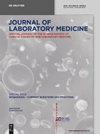EDTA-associated pseudothrombocytopenia: definition and real-world occurrence
IF 1.1
4区 医学
Q4 MEDICAL LABORATORY TECHNOLOGY
引用次数: 0
Abstract
Abstract Objectives To better characterize occurrence and extent of anticoagulant-associated pseudothrombocytopenia (PTCP) in the daily routine of a high-throughput clinical laboratory in order to draw conclusions on a more precise definition of this phenomenon. Methods Concomitant platelet counts in both EDTA and citrate whole blood (WB) performed in our laboratory over a period of four years and 9 months, were analyzed, calculating the correlation, as well as the absolute difference in the results obtained from both materials, cross-referencing these measures with automated flags for platelet aggregates and the results of the visual examination for platelet aggregates of peripheral blood smears. Results Platelet counts in both materials were strongly correlated (ρ=0.86; p<0.0001) but are on average significantly higher in EDTA WB than in citrate WB (median difference: 11 ± 14.8/nL, p<0.0001). This is in spite of numerous instances of EDTA-associated PTCP recorded in our data, where the opposite is the case. The automated flag for possible platelet aggregates was shown to be very unspecific, while a machine-learning algorithm suggested the difference in platelet counts between EDTA and citrate WB as a predictor of platelet aggregates. Conclusions EDTA-associated PTCP is a regular occurrence. Differences in platelet counts between EDTA and citrate WB appear to be a far better predictor of PTCP than automated flags. A clear and useful definition of PTCP is still missing, however, and cannot be derived from our data either, indicating the need for further research.EDTA相关的假性血小板减少症:定义和真实情况
摘要目的更好地描述高通量临床实验室日常工作中抗凝血剂相关性假性血小板减少症(PTCP)的发生率和程度,以便对这一现象做出更准确的定义。方法对我们实验室在4年零9个月的时间里进行的EDTA和柠檬酸盐全血(WB)中的伴随血小板计数进行分析,计算相关性以及从这两种材料获得的结果的绝对差异,将这些测量与血小板聚集的自动标志和外周血涂片的血小板聚集的目视检查结果进行交叉参考。结果两种材料中的血小板计数具有很强的相关性(ρ=0.86;p<0.0001),但EDTA WB的血小板计数平均显著高于柠檬酸盐WB(中位差异:11±14.8/nL,p<0.00001)。尽管我们的数据中记录了许多EDTA相关的PTCP,但情况恰恰相反。可能的血小板聚集的自动标志被证明是非常非特异性的,而机器学习算法表明EDTA和柠檬酸盐WB之间的血小板计数差异是血小板聚集的预测因素。结论EDTA相关PTCP是一种常见的PTCP。EDTA和柠檬酸盐WB之间血小板计数的差异似乎比自动标记更好地预测PTCP。然而,PTCP的明确而有用的定义仍然缺失,也无法从我们的数据中得出,这表明需要进一步研究。
本文章由计算机程序翻译,如有差异,请以英文原文为准。
求助全文
约1分钟内获得全文
求助全文
来源期刊

Journal of Laboratory Medicine
Mathematics-Discrete Mathematics and Combinatorics
CiteScore
2.50
自引率
0.00%
发文量
39
审稿时长
10 weeks
期刊介绍:
The Journal of Laboratory Medicine (JLM) is a bi-monthly published journal that reports on the latest developments in laboratory medicine. Particular focus is placed on the diagnostic aspects of the clinical laboratory, although technical, regulatory, and educational topics are equally covered. The Journal specializes in the publication of high-standard, competent and timely review articles on clinical, methodological and pathogenic aspects of modern laboratory diagnostics. These reviews are critically reviewed by expert reviewers and JLM’s Associate Editors who are specialists in the various subdisciplines of laboratory medicine. In addition, JLM publishes original research articles, case reports, point/counterpoint articles and letters to the editor, all of which are peer reviewed by at least two experts in the field.
 求助内容:
求助内容: 应助结果提醒方式:
应助结果提醒方式:


